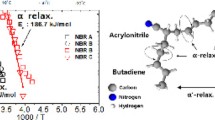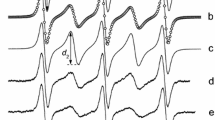Summary
An analytical expression was developed to explain the effect of molecular weight (M w ) upon the effective rotational frequencies (v eff) of different nitroxide spin probes incorporated in natural rubber. It was found that the effective activation energy (E) of probe rotation decreases with increasingM w and approaches the true activation energy (E 0) of segmental relaxations of polymer chains. Thev eff values of different probe radicals can be reduced to a single master curve by means of the equation:
whereE 0 = 7.8 kcal mol−1,v 0 = 2 x 1013 s −1 andM s = 114 g mol−1.
The value ofM s was interpreted as the smallest rotating unit of polymer chain which corresponds to a segment of about 1.7 monomer units. This leads to the interpretation that the glass transition process involves a coordinated motion of a group of about 30 short polymer segments.
As a consequence of increasing intramolecular mobility of large radicals they can be regarded as flexible chains of more or less freely rotating links. Since the intermolecular coupling of the radical rotations with segmental rotations of polymer chains increases with increasingM w it is proposed that large flexible nitroxide probes describe best the segmental relaxations of polymers.
Zusammenfassung
Es wurde ein analytischer Ausdruck abgeleitet, der den Einfluß des Molekulargewichtes (M w ) von verschiedenen, in Naturkautschuk eingebetteten Stickoxydradikalen auf ihre effektiven Rotationsfrequenzen (v eff) beschreibt. Es zeigt sich, daß die effektive Aktivierungsenergie (E) für die Rotation der paramagnetischen Sonden mit zunehmendem Molekulargewicht abnimmt. Im Grenzfall hoher Molekulargewichte strebt sie gegen den Wert der AktivierungsenergieE 0 für die segmentellen Relaxationen der Polymerketten. Diev eff Werte der verschiedenen paramagnetischen Sonden können mit Hilfe der folgenden Gleichung zu einer einfachen Masterkurve reduziert werden:
mit den WertenE 0 = 7.8 kcal mol−1,v 0 = 2·1013 s −1 undM s = 114 g mol−1.
Die GrößeM s wurde als die kleinste rotierende Einheit innerhalb der Polymerkette aufgefaßt. Sie entspricht einem Segment von ungefähr 1,7 Monomereinheiten. Dies führt zu der Interpretation, den Glasübergang als eine koordinierte Bewegung einer Gruppe von etwa 30 kurzen Polymersegmenten aufzufassen. Da die intramolekulare Beweglichkeit mit zunehmendem Molekulargewicht der paramagnetischen Sonde ansteigt, stellen große Radikale bewegliche Ketten mit mehr oder weniger frei rotierenden Gliedern dar. Mit zunehmendem MolekulargewichtM w nimmt die intermolekulare Kopplung der Radikalrotationen mit den segmentellen Rotationen der Polymerketten zu. Demnach sollten große bewegliche Stickoxydradikale die segmentellen Relaxationen der Polymerketten am besten sondieren.
Similar content being viewed by others
References
Törmälä, P., Ph. D. Dissertation, Helsinki University (Helsinki, Finland 1973).
Törmälä, P., H. Lättilä, J. J. Lindberg, Polymer14, 481 (1973).
Bullock, A. T., G. G. Cameron, P. M. Smith, Eur. Polym. J.11, 617 (1975).
Rabold, G. P., J. Polym. Sci., Part A-17, 1203 (1969).
Savolainen, A., P. Törmälä, J. Polym. Sci. (Polym. Phys. Ed.)12, 1251 (1974).
Kumler, P. L., R. F. Boyer, Macromolecules,9, 903 (1976).
Braun, D., P. Törmälä, Colloid & Polym. Sci.255, 496 (1977).
Braun, D., P. Törmälä, G. Weber, Polymer, in press.
Veksli, Z., W. G. Miller, Macromolecules10, 686 (1977).
Kovarskii, A. L., A. M. Vasserman, A. L. Buchachenko, Vysokomolek. Soedin. A13, 1647 (1971).
Bulla, I., P. Törmälä, J. J. Lindberg, Finn. Chem. Lett.1974, 129.
Vasserman, A. M., A. L. Buchachenko, A. L. Kovarskii, M. B. Neiman, Eur. Polym. J. — Supplement1969, 473.
Vasserman, A. M., T. A. Alexandrova, A. L. Buchachenko, Eur. Polym. J.12, 691 (1976).
Keinath, S. E., P. L. Kumler, R. F. Boyer, Polym. Prepr., Am. Chem. Soc., Div. Polym. Chem.16, 120 (1975).
Kumler, P. L., S. E. Keinath, R. F. Boyer, Polym. Prepr., Am. Chem. Soc., Div. Polym. Chem.17, 28 (1976).
McCrum, N. B., B. E. Read, G. Williams, Anelastic and Dielectric Effects in Polymeric Solids, p. 396 (New York, 1967).
Pechhold, W., S. Blasenbrey, Angew. Makromol. Chem.22, 3 (1972).
Gutowsky, H. S., A. Saika, M. Takeda, D. E. Woessner, J. Chem. Phys.27, 534 (1957).
Schlichter, W. P., D. D. Davis, J. Appl. Phys.34, 98 (1963).
McCall, D. W., D. R. Falcone, Trans. Faraday Soc., Part 2,66, 262 (1970).
Boyer, R. F., P. L. Kumler, Macromolecules10, 461 (1977).
Treloar, L. R. G., Rubber Chem. Technol.47, 625 (1974).
Kumler, P. L., S. E. Keinath, R. F. Boyer, Polym. Eng. Sci.17, 613 (1977).
Enns, J. B., R. Simha, J. Macromol. Sci. — Phys. Bl3, 25 (1977).
Author information
Authors and Affiliations
Additional information
With 4 figures
On leave of absence from the Institute of Materials Science, Tampere University of Technology, Tampere, Finland.
Rights and permissions
About this article
Cite this article
Weber, G., Törmälä, P. Rotations of nitroxide radicals in condensed polymeric systems. Colloid & Polymer Sci 256, 638–644 (1978). https://doi.org/10.1007/BF01784404
Received:
Issue Date:
DOI: https://doi.org/10.1007/BF01784404




